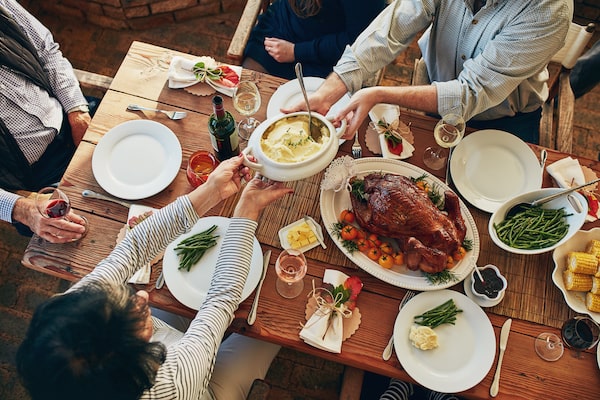
PeopleImages/iStock
Having a magnificent turkey as the centrepiece of your holiday dinner is always gratifying, but the bird causes stress for many people. To take the tension out of your dinner, here are my tried-and-true tips for roasting a turkey.
I do not wet brine turkeys. It does nothing for the texture and it makes the juices watery. Not to mention that simply having pots or vats big enough for the process is another pressure. Instead, I dry brine.
Measure out 1 tablespoon of kosher salt for every 4 pounds of turkey. Unwrap the turkey and place on a baking sheet. Rub the salt all over including throwing some in the cavity and refrigerate, uncovered, for up to two days. This also helps to make a crispier skin.
What tools do you really need in the kitchen – and which can you do without?
When it’s time to roast, rub the skin with a flavoured butter, tarragon, rosemary, garlic, lemon mix, or even a Mediterranean dry mix, and try to get some under the skin for self-basting.
Trussing helps the turkey roast more evenly by protecting the breast. It also preserves the shape after cooking and keeps the stuffing from falling out. Tie the legs together with kitchen string. Bend the wing tips under the wing to keep it close to the body. If there are no wing tips, loop a string around one wing and go under the bird to loop it onto the other wing. Pull together. If the bird is stuffed, use a metal skewer to close the cavity or sew cavity closed with a trussing needle and string.
Many years ago, I developed a way to roast turkey that I call the high-heat method. Preheat the oven to 400 F. Roast the bird for an hour then turn the heat down to 350 F. Timing is approximately 15 minutes a pound for the first 10 pounds then 7 minutes a pound after that. A 14-pound turkey will take just less than three hours, but check with an instant-read thermometer, which should read 155 F to 160 F in the thickest part. If the skin gets too brown, cover with buttered parchment paper.
Roast the bird on a rack in a roasting pan or broiler pan. This allows the air to circulate so the turkey will brown underneath as well as on top.
Let the turkey rest on a carving board for 10 to 15 minutes to let the juices retract and to make the bird easier to carve. During this time, you can make the gravy.
Find the joints for the leg and thigh and remove them whole on each side. Cut down through bones to divide thigh and drumstick. Remove wing bones. Carve the breasts in long, thin slices. Place everything on a platter.
Decorate the platter with fresh herbs, cranberries or other edible ingredients you have on hand; frisée looks pretty, seedlings too.
Today, I don’t actually roast whole birds. Instead, I butterfly or spatchcock my turkey because it cooks much faster and is much easier to carve. Have the butcher remove the backbone and crack the breast bone so the bird will lie flat. A 14-pound bird takes about 1½ to 1¾ hours to roast at 400 F using this method. Put it on a large baking sheet and place stuffing underneath if you wish. Baste occasionally if you remember. Let sit 10 minutes before carving.
Continue enjoying your turkey leftovers by storing them properly to preserve safety, quality and flavour.
More tips for a magnificent roast turkey turkey
Buy the correct sized bird
Check the size of the bird to make sure it will fit in your oven. Generally, 14-pound (seven-kilogram) birds fit in all ovens, but really big turkeys need bigger ovens.
Storage the turkey correctly
Unwrap paper and plastic from turkey. Place on a baking sheet, cover with a clean tea towel and set in the refrigerator for up to two days.
Roasting tips for a flattened turkey
For a flattened turkey, you need a large baking sheet or a large foil pan. We have used one baking sheet with another partway underneath when the turkey has been too big.
Let the turkey rest long enough
Let the bird rest on a carving board for 15 to 20 minutes to let the juices retract. The bird will be easier to carve.
Carving the bird
Find the joints for the leg and thigh and remove them whole on each side. Cut down through bones to divide thigh and leg. Remove wing bones. Carve the breasts in long thin slices. Place everything on a platter.
Serving the turkey
Decorate the platter with fresh herbs, cranberries or other edible ingredients you have on hand. Frisée looks pretty, as does arugula.